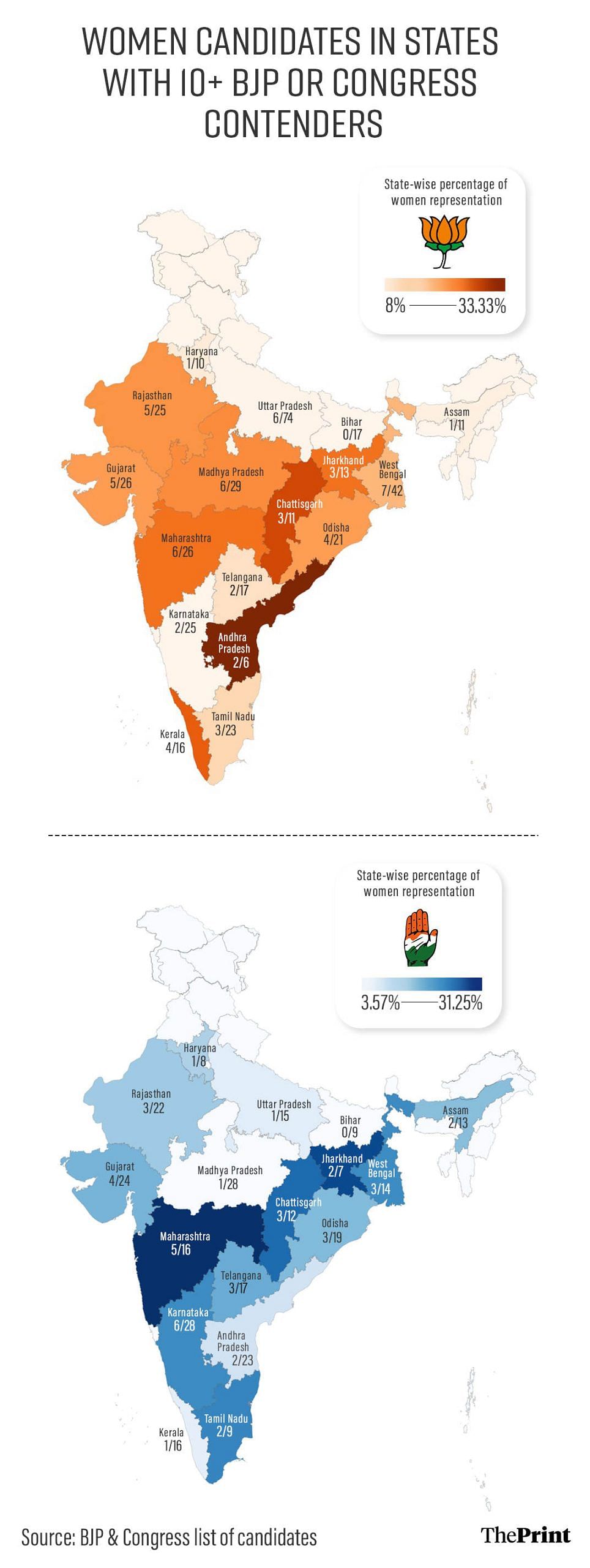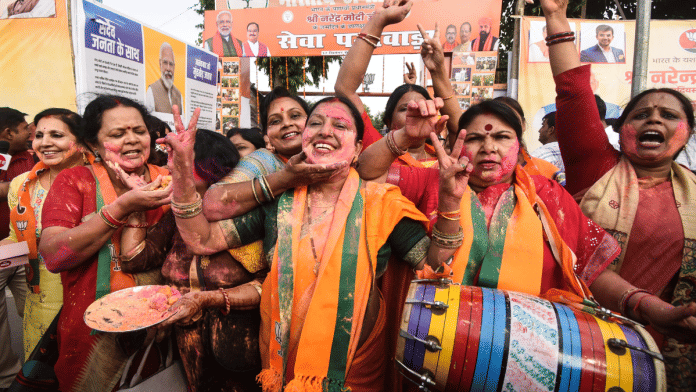New Delhi: All political parties have been enthusiastically promoting nari shakti, but when it comes to fielding women candidates in the 2024 Lok Sabha elections, they all seem to have developed cold feet, from the BJP to the Congress and AAP, an analysis by ThePrint shows.
While the BJP fielded just one woman for every six candidates, the Congress lagged behind at one in seven, suggesting that despite the passage of the women’s reservation law last September, political parties are yet to actively work toward boosting female representation in the Lok Sabha, going by their lineup for the ongoing elections.
Officially known as the Constitution (106th Amendment) Act—and dubbed as the Nari Shakti Vandan Adhiniyam by the Modi government—the new law provides 33 percent reservation to women in the Lok Sabha and state assemblies, with both the BJP and the Congress scrabbling for credit. While the new law’s implementation hinges on the next census and constituency delimitation, the grand talk surrounding it has not translated into consistent action yet.
Out of the 317 candidates declared by the Congress so far, only 13.8 percent are women. The ruling BJP has done slightly better, with women comprising 16.1 percent of its 434 candidates. Both parties have shown varying performance across states, but in Bihar neither has fielded a single woman candidate.
Also Read: Just 16% of BJP’s Lok Sabha candidates are women & over half of them are from political families
How BJP & Congress have fared
At a rally in Kerala last week, BJP national president JP Nadda brought up how the women’s reservation bill languished for 30 years “due to political reasons”, and was brought out of cold storage under Narendra Modi’s leadership. “It showcased the decisive mindset of our government,” he said.
With 70 women out of 434 candidates, the party’s representation of women in the Lok Sabha poll line-up is an improvement from the last two elections—in 2019, the BJP fielded 55 women (12.6 per cent), and in 2014, it was 38 (8.87 percent). However, it’s still nowhere close to the 33 percent goal.
In some states, women make up a larger share of candidates. In states where the party has fielded at least 10 candidates, Chhattisgarh leads with 27.2 percent women candidates (3 out of 11), followed by Kerala at 25 percent (4 out of 16), Jharkhand at 23 percent (3 out of 13), and Maharashtra at 23 percent (6 out of 26).

In Rajasthan and Madhya Pradesh, where PM Modi made rousing speeches about the women’s reservation law last September, the BJP has fielded 20 percent (5 out of 25) and 20.6 percent (6 out of 29) female candidates respectively.
In Karnataka, where it’s contesting 25 seats, the BJP fielded only 2 women candidates (8 percent). And in Uttar Pradesh, from where the party gets its maximum strength, only 6 out of 74 candidates (8.1 percent) are women.
For the Congress, which had a woman, Sonia Gandhi, as its longest-serving president, the numbers are even bleaker, showing a dip in absolute numbers but an increase in percentage from the previous two Lok Sabha elections. While it fielded 60 women (12.9 percent) in 2014 and 54 (12.8 percent) in 2019, this time it has put forth only 42 female candidates (13.9 percent).
In Chhattisgarh and Maharashtra, the party has fielded 3 women (25 percent) and 5 (31.25 percent) respectively. However, in Madhya Pradesh, only a single woman candidate has been fielded. Notably, in Andhra Pradesh, a state led by a woman, YS Sharmila, the only other Congress candidate apart from her is Lavanya Kavuri, out of a total of 23.
Last year, Rahul Gandhi had said in Kerala that the Congress has a fundamental belief that “women should be part of the power structure”, but the party has fielded only 1 woman in the state out of 16 candidates (6.25 percent)—Ramya Haridas from Alathur.
Other parties lagging too
In the national capital Delhi, Congress and AAP have not fielded a single woman among the seven seats. In fact, AAP has not nominated any women at all across its 22 candidates in Delhi, Gujarat, Punjab, Haryana, and Assam.
Do women at the helm increase the likelihood of tickets for female candidates? The data reveals a mixed picture. The Bahujan Samaj Party, led by Mayawati, has only four women candidates out of 57 declared in Uttar Pradesh, representing a mere 7 percent. Conversely, the Trinamool Congress, headed by the sole woman chief minister in the country—Mamata Banerjee—has fielded 12 women out of its 42 candidates, constituting 28.5 percent.
Also Read: BRS to TMC & BJD, many parties champion women’s quota, but don’t field them in state polls
Growing electorate, slow representation
Seventy-five years after women representatives in the constituent assembly argued against gender-based reservation, half of the population is still awaiting their fair share. Renuka Ray in the constituent assembly had argued against reservation for women. “We feel that women will get more chances in the future to come forward and work in free India, if the consideration is of ability alone,” she had said.
The situation today is such that “all political parties embrace saam, daam, dand, bhed (persuasion, purchase, punishment and secrets) to win elections”, Prof Anupama Saxena, state coordinator for Lokniti-CSDS, had earlier told ThePrint. “We have to admit that ours is a patriarchal society. Women as political leaders are not very acceptable. In fact, women across fields — administration, business, films — have less acceptance as a leader. Similar is the situation in politics.”
In a similar vein, political analyst Badri Narayan had also told ThePrint that many give men more tickets because they believe women lack the necessary “capacity” and “strength” and are not “winnable candidates”.
In a research paper, Ambar Kumar Ghosh, an associate fellow at ORF, highlighted the gradual progression in opening up spaces for women in India’s parliamentary politics.
“(B)etter educational opportunities for women, their financial stability, the relative erosion of social prejudices, coupled with greater media awareness have compelled political parties to create spaces for women’s participation,” he wrote. “With the number of women voters increasing, political parties have in recent years designed pro-women welfare policies seeking their electoral support.”
According to data from the Election Commission of India, the elector gender ratio has risen from 928 women to 1,000 men in 2019 to 948 in 2024. In 12 states/UTs, the elector gender ratio exceeds 1,000, indicating that women outnumber men in the electorate. In the 2019 Lok Sabha elections, women’s voter turnout slightly surpassed that of men. Over the years, the gap between male and female turnout has diminished, with women now overtaking men in voter turnout.
(Edited by Asavari Singh)






